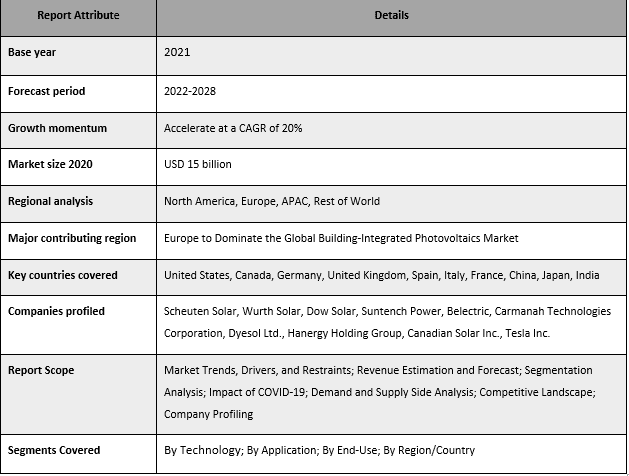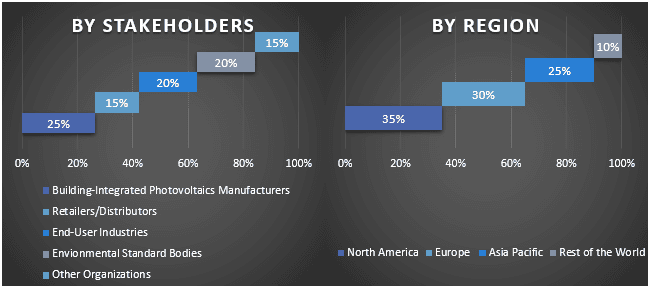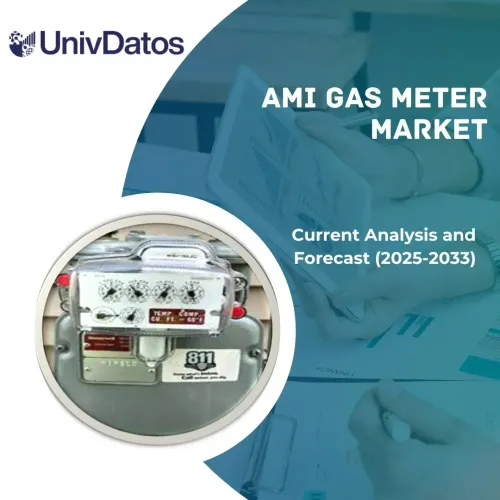- Home
- About Us
- Industry
- Services
- Reading
- Contact Us
Building-Integrated Photovoltaics Market: Current Analysis and Forecast (2022-2028)
Emphasis on Technology (Crystalline Silicon, Thin Film, Others); Application (Roof Glass, Wall, Façade, Others); End-Use (Industrial, Commercial, Residential); Region/Country

The global Building-Integrated Photovoltaics Market is expected to grow at a significant rate of 20% during the forecast period. Building integrated photovoltaics (BIPV) offers an aesthetical, economical, and technical solution to integrate solar cells harvesting solar radiation to produce electricity within the climate envelopes of buildings. The BIPVs integration with the building envelope limits the costs by serving dual purposes. In addition, BIPVs have a great advantage compared to non‐integrated systems because there is neither need for the allocation of land nor stand‐alone PV systems.
Moreover, BVIP can reduce the total building material cost owing to its on‐site electricity-producing PV modules and achieve significant savings in terms of mounting costs. Furthermore, no additional assembly components require such as brackets and rails and the BIVP system simply makes electricity out of sunlight, silently with no pollution which in turn is driving the market size of BIPV products. Furthermore, factors such as increased awareness for energy security coupled with the rapid expansion of solar photovoltaics and investment in solar energy in various countries is accentuating the growth of the building-integrated photovoltaics (BIPV) market.
Scheuten Solar, Wurth Solar, Dow Solar, Suntench Power, Belectric, Carmanah Technologies Corporation, Dyesol Ltd., Hanergy Holding Group, Canadian Solar Inc., Tesla Inc.
Insights Presented in the Report
“Amongst technology, crystalline silicon category to witness robust CAGR during the forecast period”
Based on the technology, the building-integrated photovoltaics market is segmented into crystalline silicon, thin film, and others. The crystalline silicon segment caters substantial share of the market. By using smart mounting systems, crystalline silicon cells can be integrated into building roofs by replacing the sections of the roof while keeping its integrity intact. This type of integration does not account for large investments and provides high efficiency. In addition, crystalline silicon has the highest energy conversion efficiency at present; commercial modules typically convert 13%-21% of the incident sunlight into electricity.
Building-Integrated Photovoltaics Market Report Coverage

“Amongst end-use, commercial segment to hold a significant share in the market in 2020”
Based on end-use, the building-integrated photovoltaics market is categorized into industrial, commercial, and residential. The commercial segment caters considerable share of the market. he rises in a number of retrofit projects using these installations. High emphasis on the aesthetic appeal of solar energy harnessing systems, primarily in commercial establishments, is likely to fuel the demand for BIPV. In addition, the need rising to reduce the reliance on non-renewable energy sources is also expected to accentuate the market size.
“Europe to hold a significant share in the market”
Europe is anticipated to grow at a substantial CAGR during the forecast period. This is mainly attributed to the supportive directives of the European Commission in the form of financial incentives and subsidies and declining the price of photovoltaic components is driving the market growth. For instance: The European Union (EU) established the Directive on Energy Usage in Buildings (EPBD) (Directive 2010/31/EU) and the Renewable Power Directive (1/77/EC), opening the path for near-zero and positive energy buildings. Moreover, Germany and Italy are increasingly emphasizing the use of solar energy, which is expected to translate into higher adoption of BIPV, thus promoting industry growth over the forecast period.
Reasons to buy this report:
- The study includes market sizing and forecasting analysis validated by authenticated key industry experts.
- The report presents a quick review of overall industry performance at one glance.
- The report covers an in-depth analysis of prominent industry peers with a primary focus on key business financials, product portfolio, expansion strategies, and recent developments.
- Detailed examination of drivers, restraints, key trends, and opportunities prevailing in the industry.
- The study comprehensively covers the market across different segments.
- Deep dive regional level analysis of the industry.
Customization Options:
The global Building-Integrated Photovoltaics market can further be customized as per the requirement or any other market segment. Besides this, UMI understands that you may have your own business needs, hence feel free to connect with us to get a report that completely suits your requirements.
Table of Content
Research Methodology for the Building-Integrated Photovoltaics Market Analysis (2022-2028)
Analyzing the historical market, estimating the current market, and forecasting the future market of the global Building-Integrated Photovoltaics market were the three major steps undertaken to create and analyze the adoption of Building-Integrated Photovoltaics in major regions globally. Exhaustive secondary research was conducted to collect the historical market numbers and estimate the current market size. Secondly, to validate these insights, numerous findings and assumptions were taken into consideration. Moreover, exhaustive primary interviews were also conducted, with industry experts across the value chain of the global Building-Integrated Photovoltaics market. Post assumption and validation of market numbers through primary interviews, we employed a top-down/bottom-up approach to forecasting the complete market size. Thereafter, market breakdown and data triangulation methods were adopted to estimate and analyze the market size of segments and sub-segments of the industry pertains to. Detailed methodology is explained below:
Analysis of Historical Market Size
Step 1: In-Depth Study of Secondary Sources:
Detail secondary study was conducted to obtain the historical market size of the building-Integrated Photovoltaics market through company internal sources such as annual reports & financial statements, performance presentations, press releases, etc., and external sources including journals, news & articles, government publications, competitor publications, sector reports, third-party database, and other credible publications.
Step 2: Market Segmentation:
After obtaining the historical market size of the building-Integrated Photovoltaics market, we conducted a detailed secondary analysis to gather historical market insights and share for different segments & sub-segments for major regions. Major segments are included in the report as technology, application, and end-use. Further country-level analyses were conducted to evaluate the overall adoption of testing models in that region.
Step 3: Factor Analysis:
After acquiring the historical market size of different segments and sub-segments, we conducted a detailed factor analysis to estimate the current market size of the building-Integrated Photovoltaics market. Further, we conducted factor analysis using dependent and independent variables such as various technology, application, and end-use. A thorough analysis was conducted for demand and supply-side scenarios considering top partnerships, mergers and acquisitions, business expansion, and product launches in the building-Integrated Photovoltaics market sector across the globe.
Current Market Size Estimate & Forecast
Current Market Sizing: Based on actionable insights from the above 3 steps, we arrived at the current market size, key players in the global Building-Integrated Photovoltaics market, and market shares of the segments. All the required percentage shares split, and market breakdowns were determined using the above-mentioned secondary approach and were verified through primary interviews.
Estimation & Forecasting: For market estimation and forecast, weights were assigned to different factors including drivers & trends, restraints, and opportunities available for the stakeholders. After analyzing these factors, relevant forecasting techniques i.e., the top-down/bottom-up approach were applied to arrive at the market forecast for 2027 for different segments and sub-segments across the major markets globally. The research methodology adopted to estimate the market size encompasses:
- The industry’s market size, in terms of revenue (USD) and the adoption rate of the building-Integrated Photovoltaics market across the major markets domestically
- All percentage shares, splits, and breakdowns of market segments and sub-segments
- Key players in the global Building-Integrated Photovoltaics market in terms of the product offered. Also, the growth strategies adopted by these players to compete in the fast-growing market
Market Size and Share Validation
Primary Research: In-depth interviews were conducted with the Key Opinion Leaders (KOLs) including Top Level Executives (CXO/VPs, Sales Head, Marketing Head, Operational Head, Regional Head, Country Head, etc.) across major regions. Primary research findings were then summarized, and statistical analysis was performed to prove the stated hypothesis. Inputs from primary research were consolidated with secondary findings, hence turning information into actionable insights.
Split of Primary Participants in Different Regions

Market Engineering
The data triangulation technique was employed to complete the overall market estimation and to arrive at precise statistical numbers for each segment and sub-segment of the global Building-Integrated Photovoltaics market. Data was split into several segments & sub-segments post studying various parameters and trends in the areas of technology, application, and end-use in the global Building-Integrated Photovoltaics market.
The main objective of the Global Building-Integrated Photovoltaics Market Study
The current & future market trends of the global Building-Integrated Photovoltaics market were pinpointed in the study. Investors can gain strategic insights to base their discretion for investments on the qualitative and quantitative analysis performed in the study. Current and future market trends determined the overall attractiveness of the market at a regional level, providing a platform for the industrial participant to exploit the untapped market to benefit from a first-mover advantage. Other quantitative goals of the studies include:
- Analyze the current and forecast market size of the building-Integrated Photovoltaics market in terms of value (USD). Also, analyze the current and forecast market size of different segments and sub-segments
- Segments in the study include areas of type of technology, application, and end-use.
- Define and analysis of the regulatory framework for the building-Integrated Photovoltaics
- Analyze the value chain involved with the presence of various intermediaries, along with analyzing customer and competitor behaviors of the industry.
- Analyze the current and forecast market size of the building-Integrated Photovoltaics market for the major region.
- Major countries of regions studied in the report include Asia Pacific, Europe, North America, and the Rest of the World.
- Company profiles of the building-Integrated Photovoltaics market and the growth strategies adopted by the market players to sustain in the fast-growing market
Deep dive regional level analysis of the industry
Related Reports
Customers who bought this item also bought










